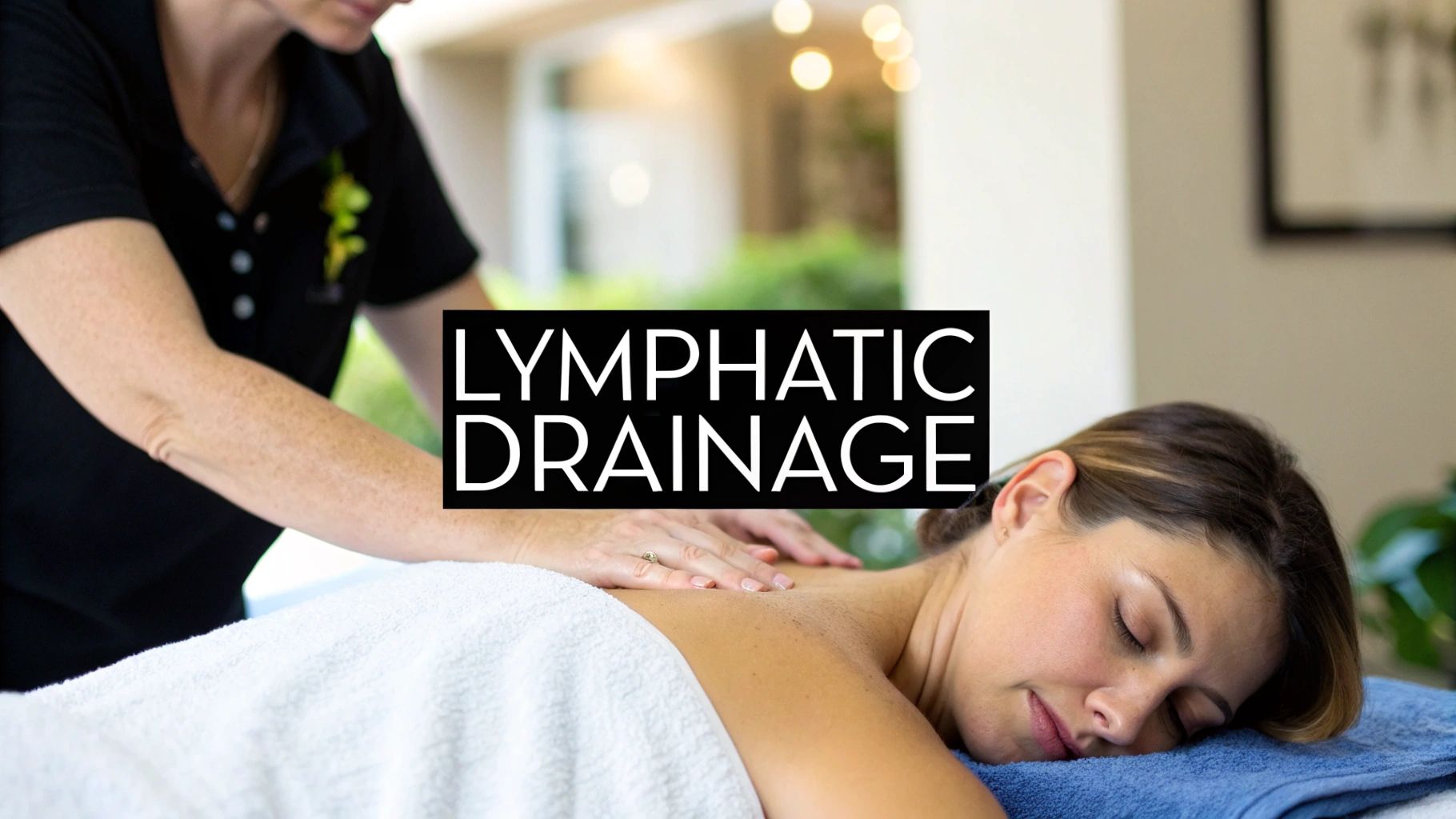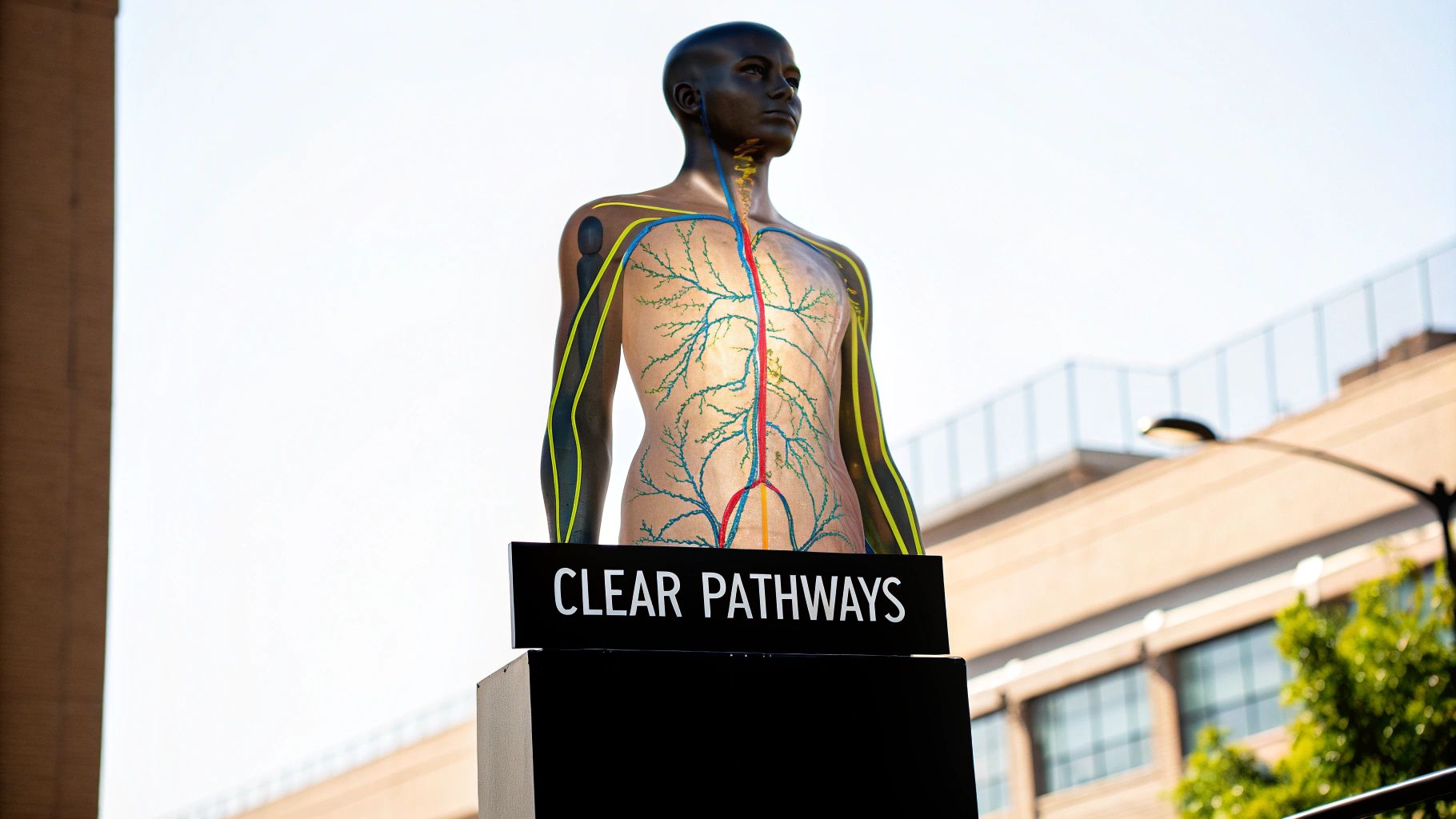
Lymphatic drainage massage is a surprisingly gentle, therapeutic technique that’s all about supporting your body’s natural detoxification process. Unlike a deep tissue massage that gets right into your muscles, this therapy uses light, rhythmic strokes to encourage the flow of lymph fluid, which helps reduce swelling and leaves you feeling lighter and more revitalised.
So, What Exactly Is a Lymphatic Drainage Massage?
Ever wondered what’s really going on with this type of massage? Picture your lymphatic system as your body’s dedicated ‘cleanup crew.’ It’s working 24/7 to clear out waste, toxins, and excess fluid. It’s a vital part of your immune system, but here’s the catch: unlike your circulatory system which has the heart to pump blood around, the lymphatic system relies on your body’s movement to get the job done.
Sometimes, this system can get a bit sluggish or overwhelmed, especially after surgery, an injury, or if you’ve been inactive for a while. That’s where this specialised massage steps in. A trained therapist uses incredibly gentle, specific movements to manually encourage the lymph fluid to move towards your lymph nodes—which act as the body’s natural filtration centres.
How Is It Different From Other Massages?
It’s really important not to mix this up with other, more forceful massage techniques. While a remedial massage works deep into the tissue to release muscle tension and knots, lymphatic drainage uses feather-light pressure. You can learn more about how different massage styles work in our guide on what is a remedial massage. The goal here isn’t to work the muscles, but to get the fluid moving properly.
At The Royal Masseur, our certified practitioners have a deep understanding of the body’s lymphatic pathways. While many competitors offer a generic “lymphatic” massage, often performed by therapists with basic training, our specialists apply deliberate, rhythmic strokes that mimic the natural pulse of the lymphatic system. This expert approach makes the treatment both effective and deeply relaxing, setting a true Manual Lymphatic Drainage (MLD) session with us apart.
This gentle therapy is a cornerstone of post-operative care and wellness, designed to reduce fluid retention and support the body’s detoxification process, helping you feel your best from the inside out.
Here in Australia, MLD is widely used to treat conditions like lymphedema, particularly after breast cancer surgery. In fact, research shows that applying MLD soon after surgery can help lower the risk of developing clinical lymphedema, which affects a significant number of survivors. You can read more about these Australian-specific findings to understand just how crucial its clinical applications are.
How Gentle Massage Unlocks Your Lymphatic System

It might seem strange that such a light touch can have such a profound effect on the body, but the science behind it is actually quite straightforward. Picture your lymphatic system as a network of slow-moving rivers flowing just underneath your skin. When these rivers get blocked or stagnant, fluid and waste build up, leaving you feeling puffy, sluggish, and heavy.
The very specific, gentle strokes of a lymphatic drainage massage act like a series of carefully placed pumps, getting that natural current flowing again. The light pressure is crucial—it’s soft on purpose to target the delicate lymphatic vessels without squashing them, which a deep tissue massage could easily do. This precise technique is what makes it so powerful.
The Science of Gentle Strokes
The magic of lymphatic drainage massage lies in its unique approach. Unlike other massage styles that dig into your muscles, this therapy focuses almost entirely on the skin and the tissues just beneath it. This is because around 70% of your lymphatic vessels are located right there.
You’ll see plenty of wellness providers advertising “lymphatic” treatments, but many use aggressive techniques like deep strokes or mechanical tools. This approach can actually overwhelm and collapse the fragile lymphatic capillaries, causing more harm than good. A true Manual Lymphatic Drainage (MLD) session, like the ones our specialists at The Royal Masseur perform, is always gentle.
Our practitioners have a deep understanding of the body’s lymphatic pathways. They use rhythmic, stretching motions on the skin to coax the vessel walls into contracting, which naturally pushes the fluid forward.
The goal isn’t to force fluid out but to guide it along its natural pathways toward the lymph nodes. Think of these nodes as the body’s ‘filtration stations’—they process and eliminate waste. This is the fundamental difference between authentic MLD and a generalised massage.
Why Technique Matters More Than Pressure
The direction of the strokes is every bit as important as the pressure. A trained therapist works methodically, clearing the central areas of your body first. This creates an open pathway, making space for fluid from your arms and legs to drain properly. It’s a systematic approach that ensures the entire system is cleared out efficiently.
In contrast, someone without proper training might just push fluid around aimlessly. This might offer a moment of relief, but it doesn’t solve the underlying problem. At The Royal Masseur, our certified therapists ensure every single movement has a purpose, maximising the detoxifying benefits and supporting your body’s own healing process, a level of detail often overlooked by competitors offering quick-fix solutions.
The Real Benefits of Lymphatic Drainage

While a standard massage is fantastic for working out knots in your muscles, lymphatic drainage works on a much deeper, more fundamental level. It’s less about muscle relaxation and more about enhancing your body’s natural processes, touching everything from recovery after surgery to your general sense of wellbeing.
One of its most celebrated talents is the incredible ability to reduce swelling and fluid retention. If you’ve had surgery, you know that uncomfortable, persistent swelling (oedema) that can hang around. This happens because the lymphatic pathways get disrupted. Lymphatic drainage massage gently nudges that excess fluid back into circulation, which can seriously speed up healing and even help minimise scarring.
Of course, it’s not just for post-op care. Heaps of people in Australia rely on this therapy to manage chronic conditions like lymphedema, where keeping fluid moving is absolutely essential for a good quality of life.
Beyond Swelling Reduction
But getting fluid moving is only part of the story. Think of this therapy as a powerful boost for your immune system. By helping clear out all the metabolic gunk and cellular waste, it basically lightens the load on your body’s defence crew. The results? You can actually see and feel them.
- Brighter, Clearer Skin: When you clear out that stagnant fluid just beneath the skin, it often reduces puffiness and gives your complexion a healthy, radiant glow.
- A Noticeable Energy Boost: With your internal “cleanup crew” working at peak efficiency, that sluggish, weighed-down feeling often lifts, leaving you feeling much more revitalised.
- Calmer Nerves: The soft, rhythmic nature of the massage is incredibly soothing for the nervous system. It’s not uncommon to feel a profound sense of relaxation and lightness wash over you.
A quick heads-up: many general massage providers might say they offer lymphatic benefits, but often their techniques are way too firm. At The Royal Masseur, our certified therapists know the difference. We use precise, feather-light strokes designed to work with your lymphatic system, not against it, so you get the genuine therapeutic results you’re after.
Ultimately, every benefit comes back to one simple idea: supporting your body’s natural functions can have a massive impact on your overall health. It’s a gentle reset that helps you feel amazing from the inside out.
Finding a True Lymphatic Drainage Specialist
Let’s be clear: not all massages advertised as “lymphatic” are the genuine article. It’s a bit of a Wild West out there, so choosing the right provider is absolutely critical for your safety and results. You need someone who is a certified Manual Lymphatic Drainage (MLD) therapist, not just a general massage therapist who’s decided to add it to their menu.
A true MLD specialist has an entirely different skill set. They understand the body’s delicate lymphatic map and use gentle, rhythmic, and incredibly precise movements designed to encourage flow without overwhelming the system. A general massage therapist, on the other hand, might use pressure that’s far too firm. This can actually collapse the fragile lymphatic vessels, doing more harm than good by hindering drainage instead of helping it.
What to Look for in a Provider
When you’re searching for a practitioner, their qualifications are non-negotiable. Don’t be shy about asking for specific certifications in Manual Lymphatic Drainage from a reputable institution. A true professional will always start with a detailed consultation to get a full picture of your medical history, your concerns, and what you’re hoping to achieve. This initial chat is one of the clearest signs you’re in expert hands.
The infographic below really gets to the heart of what authentic MLD is all about—the use of gentle, deliberate strokes that support the body’s natural processes.
This light touch isn’t just for comfort; it’s fundamental to an effective treatment. It ensures the delicate lymphatic vessels are stimulated correctly to get that fluid moving.
The need for this kind of specialisation is even more crucial when you consider the gaps in standard medical training. It’s pretty shocking, but a 2022 Australian survey revealed that most recent medical graduates felt their knowledge of the lymphatic system was poor, with their training often lasting less than 30 minutes. This educational shortfall can lead to delayed referrals for crucial treatments like MLD. You can read the full research about these findings to see just how important it is to seek out a proper specialist yourself.
To make the distinction clearer, here’s a quick comparison of what separates a dedicated MLD specialist from a general massage provider.
MLD Specialist vs General Massage Therapist
Understanding the crucial differences in training, technique, and outcomes between a certified MLD specialist and a general provider.
| Feature | The Royal Masseur (MLD Specialist) | General Massage Provider |
|---|---|---|
| Training | Extensive, certified MLD training (e.g., Dr Vodder, Casley-Smith) focusing on lymphatic anatomy & physiology. | Basic massage therapy training, with little to no specialised lymphatic education. |
| Technique | Gentle, rhythmic, precise strokes designed to stretch the skin and stimulate lymphatic capillaries. | Often uses deeper pressure (e.g., Swedish, deep tissue) that is inappropriate and potentially harmful for the lymphatic system. |
| Pressure | Extremely light and specific, never causing pain or redness. | Can range from light to very firm, which may collapse delicate lymphatic vessels. |
| Goal | To manually redirect and encourage the flow of lymphatic fluid, reducing swelling and supporting immune function. | Primarily focused on muscle relaxation, relieving tension, and improving blood circulation. |
| Consultation | In-depth medical history intake is mandatory to ensure safety and tailor the session to specific health needs. | General intake focused on muscle soreness and relaxation preferences. |
As you can see, the expertise is worlds apart. Trusting your lymphatic health to someone without the right training is a risk not worth taking.
At The Royal Masseur, our practitioners are not just massage therapists; they are certified MLD specialists. We prioritise a detailed consultation to ensure the treatment is perfectly aligned with your health needs, guaranteeing a safe and effective experience.
Ultimately, putting in the time to find a properly qualified therapist is an investment in your health. It ensures you receive authentic, expert care that actually works. For more advice on how to vet practitioners, have a look at our guide on choosing a top-rated massage therapist in Sydney.
Your First Lymphatic Drainage Session
Knowing what to expect can make your first lymphatic drainage massage a much more relaxing and effective experience. The whole thing is designed to be incredibly gentle and restorative, starting with a proper chat where your therapist gets to know your health history and what you’re hoping to achieve.
Unlike a remedial massage that digs into sore muscles, this treatment feels completely different. It’s all about unique, feather-light strokes. Your therapist uses precise, rhythmic motions right on the surface of your skin to get the lymphatic vessels working.
They’ll focus on key areas like your neck, armpits, and groin, which is where you have large clusters of lymph nodes that act as the body’s main filtration stations. It’s a very methodical process, designed to guide fluid along its natural pathways.
The Royal Masseur Difference
Lots of clinics might offer a generalised “lymphatic” treatment, but a true Manual Lymphatic Drainage (MLD) session takes specialised expertise. Here at The Royal Masseur, our certified MLD practitioners have advanced training in lymphatic anatomy.
They understand that the wrong pressure or direction isn’t just ineffective—it can actually be harmful. It’s a small detail that many general massage providers miss. We take the time to conduct a thorough consultation and tailor each session to your body’s specific needs, a personalised approach that sets us apart from high-volume clinics. We make sure every single stroke is purposeful, delivering real therapeutic results, safely.
Expect to feel incredibly light and deeply relaxed afterwards. It’s also very common to feel the need to pop to the loo more often, as your body starts flushing out all that mobilised fluid. It’s a clear sign the treatment is doing its job!
Simple aftercare, like drinking plenty of water, helps you get the most out of your session. While this therapy is becoming more widely appreciated, getting access to it can still be a challenge in some parts of Australia.
For example, some Aboriginal communities face significant hurdles in receiving regular MLD treatments due to a lack of available providers and affordability issues. This can lead to poorer management of chronic conditions like lymphoedema. You can discover more insights about lymphatic care in Australia and see just how important accessible services are.
Common Questions About Lymphatic Massage
Dipping your toes into a new kind of therapy always brings up a few questions. It’s completely normal! To help you feel confident and ready, we’ve put together some straight-up answers to the queries we hear the most.
Is Lymphatic Drainage Massage Painful?
Not at all. In fact, it’s one of the most gentle therapies you can experience. A common myth is that for a massage to work, it has to be firm, but that couldn’t be further from the truth with Manual Lymphatic Drainage (MLD).
MLD is incredibly gentle and should never hurt. The whole point is to use light, rhythmic strokes that get the delicate lymphatic vessels just under your skin moving. Most people find the soft, repetitive motions deeply relaxing and it often has a wonderful calming effect on the entire nervous system.
At The Royal Masseur, our certified MLD specialists know exactly how to apply that precise, feather-light touch needed for real results. Someone without this specialised training, which is common at generalist wellness centres, might press too hard. This doesn’t just feel uncomfortable—it can actually squash the very vessels you’re trying to clear, undermining the entire purpose of the treatment.
How Often Should I Get This Massage?
The right frequency really comes down to you and what you’re hoping to achieve. If you’re managing a specific health concern like lymphedema or you’re recovering from surgery, your therapist will map out a treatment plan to get you the best possible outcome.
For general wellness—maybe to tackle a bit of puffiness or just give your body’s detox system a boost—a session once a month or every couple of months could be perfect. It’s also an absolute lifesaver for expecting mothers dealing with pregnancy-related swelling. You can learn more about its benefits in our guide to safe prenatal care for expecting moms. The best path forward is always a chat with your therapist to create a schedule that fits your life and your goals.
Who Should Avoid Lymphatic Drainage?
While it’s an extremely safe and gentle therapy for most, it’s not the right fit for everyone. It’s really important to steer clear of lymphatic drainage if you have certain health conditions.
This includes anyone with:
- Congestive heart failure
- An active infection or fever
- Kidney problems
- A history of blood clots (DVT or thrombosis)
Being open and honest is crucial for your safety. Always share your complete medical history with your therapist during your consultation. If you’re unsure about anything, have a quick chat with your doctor before booking in.
How Is It Different From a Regular Massage?
The biggest differences are the pressure and the purpose. Think of a standard Swedish or deep tissue massage—it’s all about using firm pressure to get into the muscles, work out knots, and release that deep-seated tension. The main goal is to relax your muscles.
Lymphatic drainage is a completely different ball game. It uses incredibly light, specific strokes that target the lymphatic system only, not the muscles underneath. The aim is to encourage fluid to move along, reduce swelling, and support your body’s natural cleansing process. The technique, the feel, and the final outcome are worlds apart, making it a highly specialised treatment.
Ready to feel the gentle, restorative power of an authentic Manual Lymphatic Drainage massage? The team at The Royal Masseur brings expert, certified care right to your doorstep, whether that’s at home, in a hotel, or at the office. Book your session today and experience what a difference specialised knowledge makes.
